Table of Contents
Blepharoplasty: Ultimate Solution for Droopy Eyelids
Blepharoplasty is a procedure that helps rejuvenate aging and tired-looking eyes or is the ultimate solution for droopy eyelids.
Blepharoplasty is a procedure that helps rejuvenate aging and tired-looking eyes or is the ultimate solution for droopy eyelids.
There’s more to your eyes than serving as a doorway to your soul.
There’s more to your eyes than serving as a doorway to your soul. They are the center of attention on your face. They show how you are feeling—stressed, exhausted, elated, or surprised—and frequently, they make you look older.
They are the center of attention on your face. They show how you are feeling—stressed, exhausted, elated, or surprised—and frequently, they make you look older.
For instance, extra skin on the lower lids might make someone appear older than they actually are.
As the thinnest, most sensitive skin on our bodies, our eyelids are where the majority of the aging indications manifest themselves. As a result, the area around our eyes ages more rapidly than most other parts of our bodies.
We’ll provide you with a thorough guide to blepharoplasty in this article, including the before, during, and after the procedure, the recovery phase, suitable candidates, where to have the procedure, and the associated costs.
Blepharoplasty or Eyelid Surgery
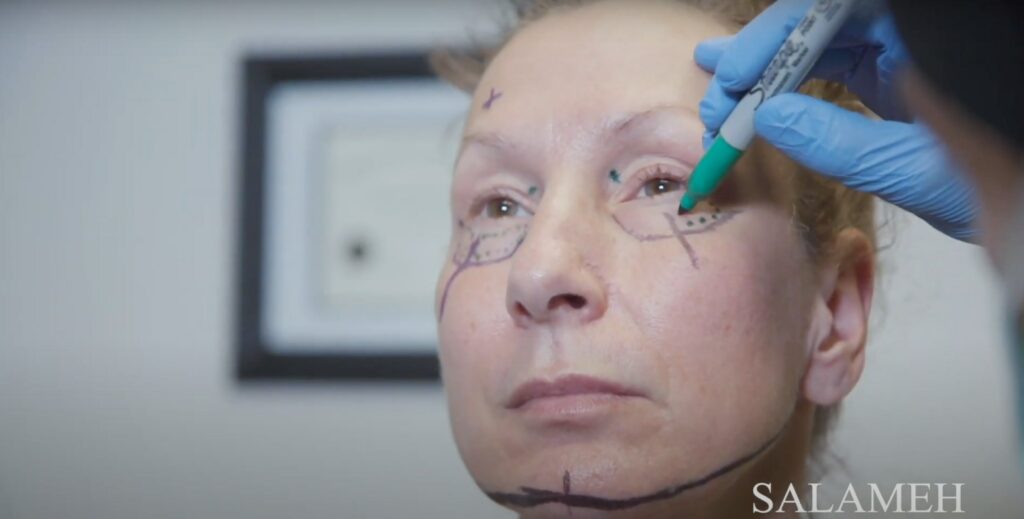
Blepharoplasty or eyelid surgery is a medical procedure that helps restore youthfulness and openness to lower or upper lids that have sagged or drooped.
Most patients have eyelid surgery to look younger and more relaxed.
Eyelid surgery can address sagging skin that develops with age. It also helps other patient issues such as Xanthelasma, black bags beneath the eyes, and drooping lower lids that reveal the whites of the eyes.
Causes of Droopy Eyelids
Drooping eyelids, also known as ptosis, can develop for various reasons, including muscle weakness that lifts the eyelid, nerve injury, or skin looseness of the upper eyelids.
It might result from normal aging, being present at birth, or an injury or sickness.
Tumors around or behind the eye, diabetes, Horner syndrome, myasthenia gravis, stroke, or swelling in the eyelid (such as with a stye) can all lead to eyelid drooping.
People choose to have blepharoplasty for a variety of reasons:
- sagging upper eyelids
- upper eyelid skin that is too thick
- lower eyelid skin that is too thick
- eyes under the bags
- skin that is thin and finely wrinkled
- fat accumulation on the eyelids
- eyes that seem hollow-looking
You would want to look younger and more awake. Also, the extra skin around your eyes may be obstructing your peripheral vision, making daily activities like driving challenging.
Blepharoplasty may be the best option for you if you have:
Types
There are three different forms of eyelid surgery: upper blepharoplasty, lower blepharoplasty, and double blepharoplasty.
Upper Blepharoplasty
To create a less-tired and more youthful appearance, an upper eyelid lift, also known as an upper blepharoplasty, is a good option. It involves removing the folds of loose skin and bulges of projecting fat that sit over the top eyelids.
The skin and muscles surrounding the eyes weaken and stretch due to gravity’s downward pull and a loss of skin elasticity. This leads to an accumulation of loose skin and fat protrusions. These give the impression of “eye bags” or a hooded appearance of the upper eyelid skin.
Smoking, sun exposure, and weight loss may all have an accelerating effect on this feature.
To conceal any scars, a surgeon creates an incision during upper blepharoplasty in the eyelid’s natural crease. He will then tighten the existing muscles and remove fat deposits and loose skin.
After the treatment is finished, the incisions are stitched or glued shut.
This surgery can be combined with other procedures, such as fillers or other injectables to further give the upper eye area a fuller appearance.
Lower Blepharoplasty
On the other hand, lower blepharoplasty is a treatment that helps remodel the skin of the lower eyelids by removing eye bags and extra fat.
This surgery is intended to improve under-eye bags, wrinkles, and drooping skin, which can make people appear older or weary.
During the procedure, the surgeon will create an incision along the lower lash line or on the inside of the eyelid during the surgery to remove extra tissue and tighten the skin.
This procedure is for those who:
- possess severe dark circles
- possess severely sagging skin around your eyes.
- possess eye bags
- has eyes that look droopy or wrinkled
- needs to get the fat under your eyes removed
Double Blepharoplasty
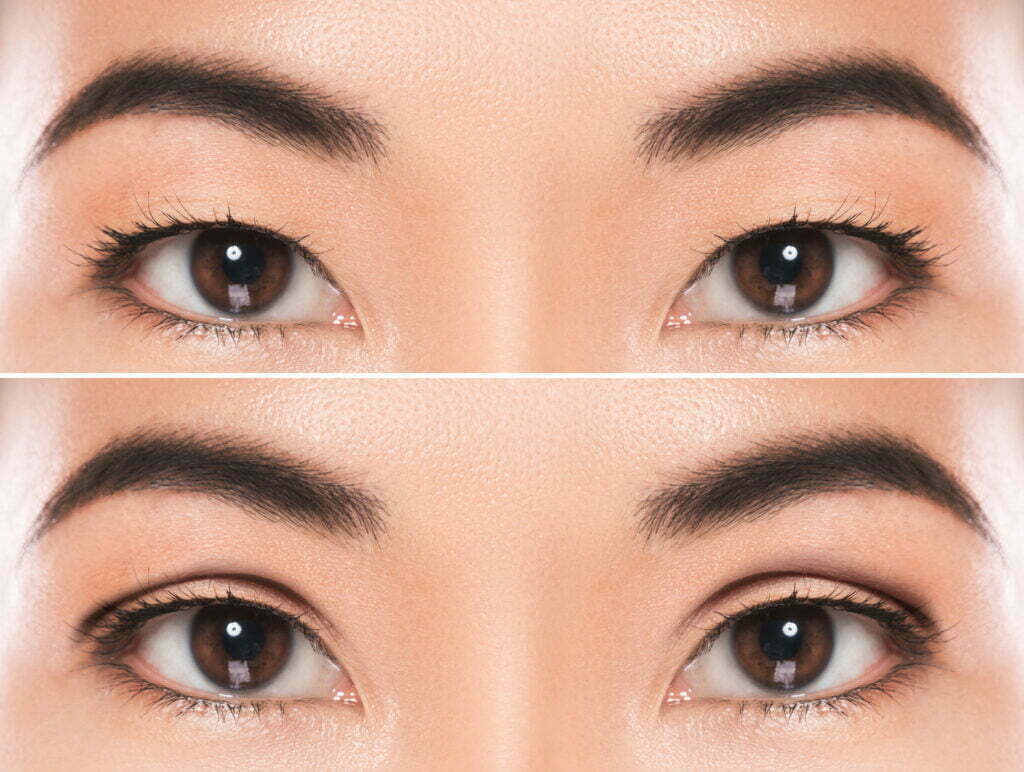
Also known as double eyelid surgery, double blepharoplasty serves a very different goal.
It’s a technique that commonly treats monolid, a condition in which there isn’t a natural fold in the upper eyelid between the eyelashes and the eyebrow.
The procedure widens the gap between the upper and lower lids by forming a crease in the upper lid, giving the eyes a bigger appearance.
Patients of Asian heritage with monolid eyelids frequently have this operation.
Eligibility for the Procedure
Those in good physical shape and without visual issues are suitable candidates for blepharoplasty.
Although patients as young as 35 frequently want the operation, the majority of patients in the US who have this treatment are middle-aged or older.
An excellent candidate is someone who:
- has creases or drooping due to sagging skin
- has fat deposits that are too much, causing puffiness in the upper eyelid
- has droopy lower eyelids or bags under the eyes
- is generally in excellent health
- not a smoker or willing to stop smoking for a given period
- has reasonable expectations and ambitions
If you have any of these problems and want to revitalize your eyes, a blepharoplasty treatment may be a good option for you.
Things to Prepare

You will consult with a medical professional before scheduling blepharoplasty.
The conversation covers:
- Your medical background. Your healthcare professional will inquire about prior operations.
Additionally, your doctor can inquire about any existing or previous illnesses. These conditions include diabetes, glaucoma, circulatory issues, allergies, thyroid issues, and dry eyes.
Your doctor will also inquire about your usage of prescription medications, over-the-counter medications, herbal supplements, alcohol, and illicit drugs.
- Your goals. Setting the stage for a successful outcome will involve talking about what you hope to gain from the procedure.
If the operation is likely to be successful for you, your healthcare professional will discuss this with you.
Your surgeon will likely ask you to avoid using warfarin (Jantoven), aspirin, ibuprofen (Advil, Motrin IB, and other brands), naproxen sodium (Aleve and other brands), and naproxen (Naprosyn).
They may also tell you to stop herbal supplements that can make bleeding worse.
You should ask your surgeon how long you should wait to stop taking these medications before surgery. Make sure to take only the medications that your surgeon has prescribed.
Blepharoplasty: The Surgery Process
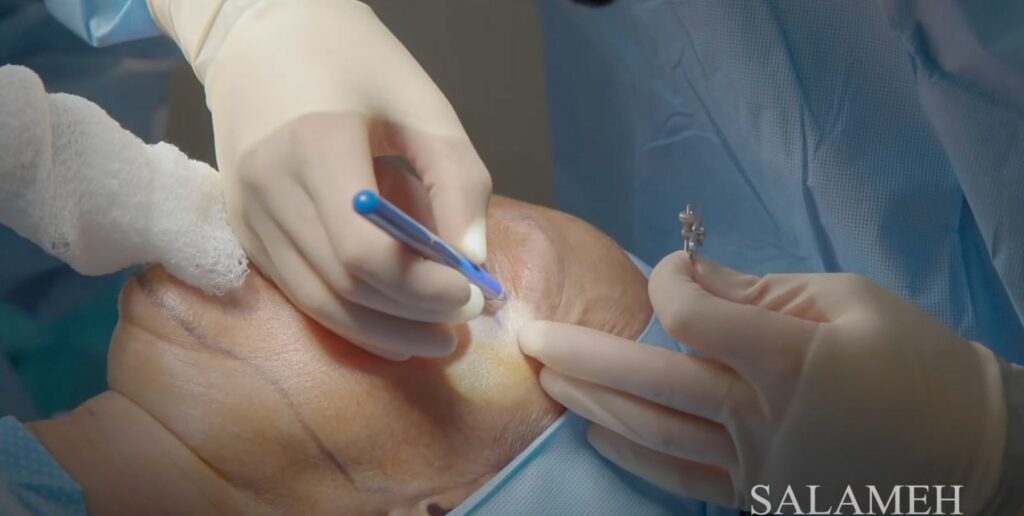
Before making the initial cut, eyelid surgery involves considerable planning.
One of the most crucial blepharoplasty procedure stages is marking the skin of the eyelids for excision. Your surgeon will take particular care in planning the blepharoplasty incision lines.
He will accurately mark the eyelid skin to prepare it for surgical excision before beginning the procedure.
The procedure is performed on an outpatient basis. You can leave the recovery area when the procedure is finished and return home the same day.
Blepharoplasty takes 1-2 hours if both upper and lower eyelids are done at the same time.
Your surgeon will make small incisions during the procedure in the eyelids’ natural folds. This is to minimize clear signs of the procedure while the patient is recovering.
The extra skin and/or fat that is the root of the eyelid issue is removed by drawing it out from within the incisions.
It is reinforced and made taut again to lift sagging skin and muscular tissue. Once the procedure is over, the eyelids return to being naturally youthful.
Recovery and Aftercare
Expect to receive comprehensive post-operative care instructions from your surgeon.
Using a cold compress, such as an ice pack, for the first day or two following the treatment can reduce any swelling. An eye lubricant may also be administered to you. Note that this could briefly impair your eyesight.
And until you receive the all-clear, stay away from physically demanding activities like sports.
For a few days, patients won’t have their full, best vision. So, it’s a good idea to prepare ahead of time and get help for some tasks, such as driving or cooking.
During the first several weeks, it is normal for your eyes to tire more than usual.
Rest is essential during this period. If you must use a computer, think about scheduling your work so that you have longer rests between shorter sessions.
Additionally, it’s crucial to shield the eyes from the light and wind. When you walk outside, wear dark shades that offer enough coverage. You can also ask your surgeon if you have any queries on sunscreen or cosmetics.
Risks and Complications
Before undergoing any procedure, you must always consider its risks and potential complications.
Risks associated with eyelid surgery include:
- bleeding coming from the scar lines
- skin feeling changes or numbness in the eyelashes
- having trouble shutting your eyes
- eyes that are dry
- ectropion, a rolling of the lower eyelid outward,
- Infection
- lower eyelid pulling down, known as lid lag, is possible and frequently transient.
- pain that could last a while
- potentially requiring revision surgery
- sensitivity to bright light, such as the sun
- bruising and swelling
- a very small probability of blindness and a temporary or perhaps permanent alteration in vision
- negative scarring
Before you give your consent, all risks, including these ones, should be disclosed. It’s crucial that you ask your plastic surgeon all your questions up front.
Working with a board-certified plastic surgeon is the greatest option to reduce the likelihood of these dangers occurring.
Blepharoplasty Before and After
Blepharoplasty, often known as eyelid surgery, is a popular cosmetic procedure with noticeable before and after outcomes.
The procedure can make the area around the eyes look more youthful and rested by reducing extra skin, puffiness, and sagging.
The before and after images reveal a noticeable improvement in the patient’s eye area.
Upper Blepharoplasty Before and After
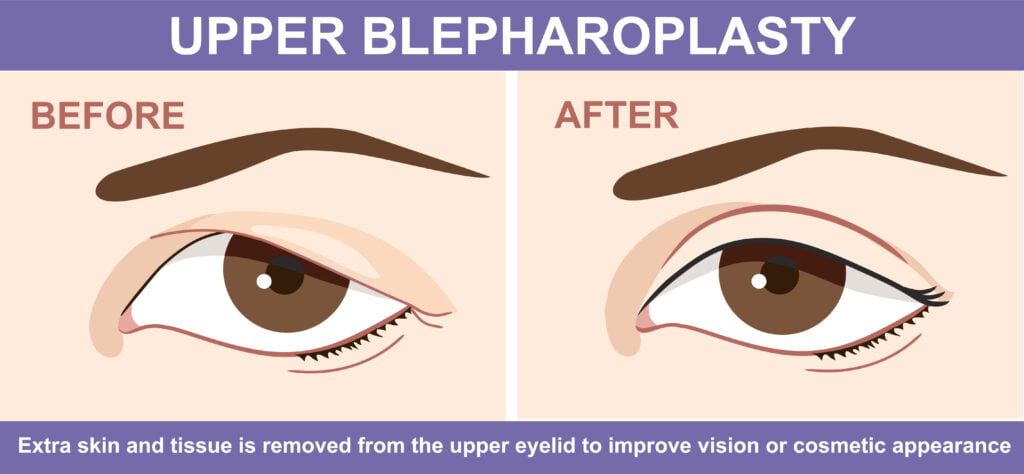
To give you an idea, here’s what an upper blepharoplasty before and after would look like.
You can see the upper eyelid appearing more lifted and youthful.
This graphic assists patients in visualizing the procedure’s prospective outcomes.
Lower Blepharoplasty Before and After
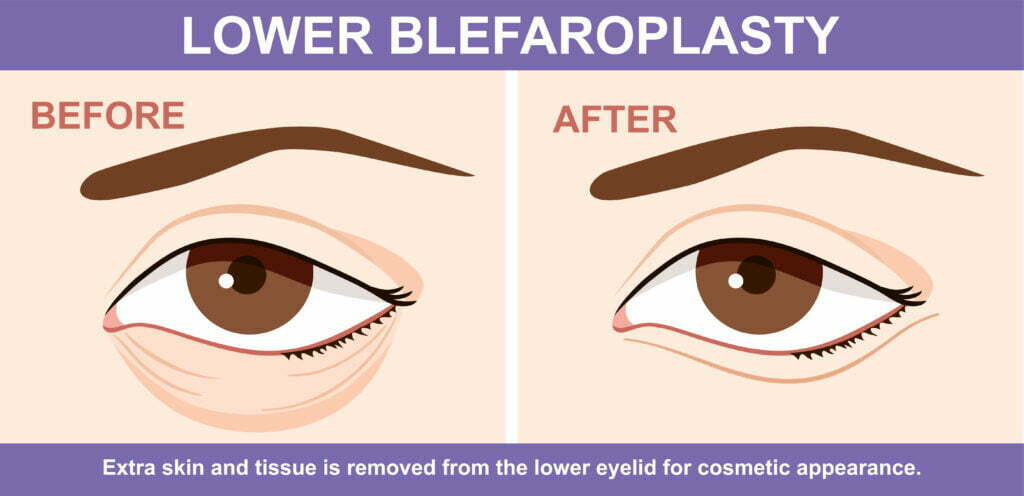
The lower blepharoplasty image shows a dramatic improvement in the patient’s lower eyelid area. You can see a significant reduction in puffiness and creases and a more revitalized and energized appearance.
At Salameh Plastic Surgery Center, we take pride in our patients’ eyelid surgery results. For our blepharoplasty before and after photos, you may find them here: Before & After Gallery.
Celebrity Blepharoplasty Before and After
Even superstars strive to maintain their best appearance.
Celebrities care about their looks. Their appearance and financial situation are also impacted if they have extreme eyelid sagging.
The internet is flooded with before and after pictures of celebrity blepharoplasty, which offer a glimpse into the procedure’s transformational results.
Dolly Parton and Renée Zellweger are two of the most well-known celebrities to have had blepharoplasty.
Blepharoplasty Cost
The American Society of Plastic Surgeons’ most current figures show that the average cost of eyelid surgery is $4,120.
Anesthesia, operating room equipment, and other related costs are not included in this average cost, which represents only a portion of the whole cost.
For information on your final cost, don’t hesitate to get in touch with the office of your plastic surgeon.
The cost of eyelid surgery will depend on the surgeon’s fees, the technique used, and the location of the office.
Be sure to ask your surgeon whether they offer patient financing options for eyelid surgery.
Blepharoplasty Near Me: Eyelid Surgery in Kentucky & Indiana
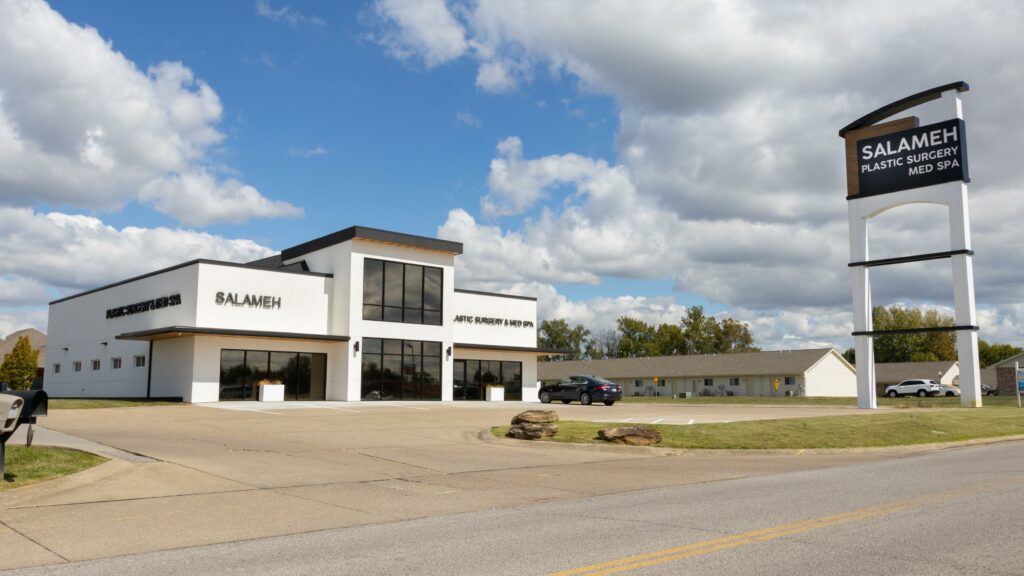
Blepharoplasty remains one of our most popular procedures at Salameh Plastic Surgery Center. This is because it provides patients with immediate results, excellent outcomes, and little recovery time.
If you’re thinking about blepharoplasty, look no further than Salameh Plastic Surgery Center.
Our board-certified plastic surgeons will help you through the procedure. We also guarantee you the greatest outcomes.
We have two easy-to-reach locations in Indiana and Kentucky, and we’re here to offer you first-rate care and support your cosmetic objectives.
Make an appointment for a consultation with us right away to start on the path to a more revitalized and youthful appearance.
Takeaway
Blepharoplasty can treat sagging or drooping eyelids and remove obstacles to vision.
It involves making incisions along the creases of the eyelid and then removing extra skin or fat that has shifted from its ideal location.
To avoid future sagging of the skin, the surgeon may also attach it to the underlying face structure.
Working with a board-certified plastic surgeon is essential for the greatest results.

